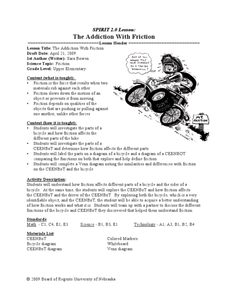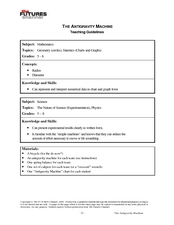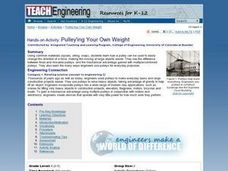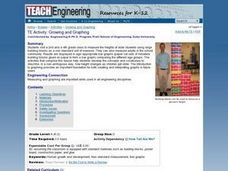Curated OER
Power to the Pedal!
In this pedal power worksheet, students solve a math puzzle in order to determine how much power could be generated by pedaling a bicycle. They try to figure out how much power would be needed to run a child's laptop, and how much...
Curated OER
Gears and Proportions
Students explore gears. In this simple machines and ratio instructional activity, students view a video clip in which front and rear bicycle gears are explained. From a set of gear combinations and gear ratios, students identify...
Curated OER
The Addiction With Friction
Students compare and contrast where friction occurs in robots and bicycles. In this science lesson, students label the diagram of bicycle and robots. They investigate how friction affects their different parts.
Curated OER
The Anti-Gravity Machine
Students examine physics by completing a bicycle experiment in class. In this gravity lesson, students measure the characteristics of different bicycles and compare their different race times. Students utilize a shoebox,...
Curated OER
A Bicycle Trip
In this bicycle worksheet, students learn how the gears of a bicycle transfer energy. This worksheet has 2 short answer questions and 5 problems to solve.
Curated OER
The Gear Game
Students discuss that the conservatin of energy states that the energy imput must equal the energy output. They then figure out how can a machine help you to perform task otherwise considered impossible? Students discuss the six simple...
Curated OER
Stressed and Strained
Learners explore stress and strength in engineering design. In this engineering lesson, students become familiar with terminology associated with stress and strain on building material. They will have a class discuss about how their beam...
Teach Engineering
Edible Rovers (High School)
Design and build a rover ... then eat it? This activity has groups of two design and build Mars rovers. The teams determine what instruments they want to include with their rover and plan a budget. They calculate the cost of the body of...
Curated OER
What is a Wheel and Axle?
Stuents explore wheels and axles and how they maka machine move. After a teacher demonstration, students construct a wheel and axle. Students explore the circumference of the wheel. They compare the wheel sizes, speed, distance, and load...
Curated OER
TE Activity: Pulley'ing Your Own Weight
Students experiment with common objects such as spools, string and soap to determine how pulleys make it easier to move large objects. They look at the difference between fixed and movable pulleys. They examine the many uses engineers...
Curated OER
So Fast! So Slow!
Fifth graders give examples of objects that move slow and fast. In this physics lesson, 5th graders rank animals according to how quickly they move. They create a bar graph of organisms versus rates of speed.
Curated OER
Gearing Up--Learning About Gears
In this learning about gears learning exercise, 5th graders read and discuss a 1 page article on gears, fill in 7 blanks to complete 5 facts about gears and make a set of gears from a template provided in the learning exercise.
Curated OER
Growing and Graphing
Learners visit a 2nd and a 4th grade class to measure the heights of older students using large building blocks as a non-standard unit of measure. They can also measure adults in the school community. Results are displayed in...
Curated OER
Recycling
Students examine different "cycles" that are found in nature, such as the water cycle and recycling. They create their own artwork about cycles to be displayed on a bulletin board
Curated OER
GPS Receiver Basics
Students practice using a GPS receiver. They walk in different directions and monitor their progress on maps. They enter specific locations and use information given to them to get them back to their original locations.
Curated OER
Aerodynamics of Cycling
Young scholars study aerodynamic forces - lift and drag - and see how those forces affect cycling performance. They see how those forces are calculated and how
Teach Engineering
Can You Take the Pressure?
Do not let the pressure get to you. The first lesson plan in a unit of 22 introduces the concept of air pressure. Using background knowledge, the resource gives teachers the information they need to discuss how people measure air...
Teach Engineering
Egg-cellent Landing
The classic egg-drop experiment gets a new bounce with an activity that asks pairs to design a lander similar to one used to land a rover on Mars within a fixed budget. The activity provides a great introduction to the idea of...
Teach Engineering
Investigating Torque
Torque--a teachable moment? Here's a lesson on torque (or moment) and variables that include size, reinforcement, structural bracing, and material that affect torque.
Teach Engineering
Levers that Lift
Introduce your class to to the remaining three simple machines-- the lever, pulley, and the wheel-and-axle with a plan that includes the three different types of levers in the discussion of levers. The lesson continues with the...
Curated OER
Abiotic and Biotic Factors
Students examine abiotic and biotic factors. They define biotic and abiotic, categorize a list of items onto a Venn diagram, label various items from areas on the school grounds as biotic or abiotic, and diagram a magazine picture.
Curated OER
Do You Have the Strength?
Learners examine the strength and resilience of the human heart. They squeeze a tennis ball to demonstrate the strength of the human heart, record and analyze the results on a worksheet, and create a poster of a design of a device to...
Curated OER
Slope of a Line
In this slope of a line worksheet, students read about line graphs and plotting the slope of a line. They read about the rate of change which is represented by the slope. Students practice finding the slope of lines.
Curated OER
Riding the Gravity Wave
Students write a sketch of an artist or athlete that has pushed the limits on gravity. They explore concepts of rhythm, balance and friction. They examine how engineers design sports equipment.























